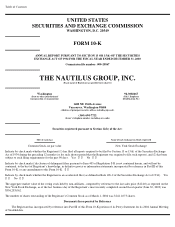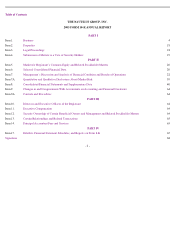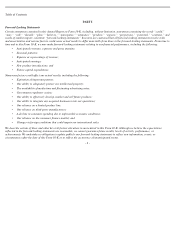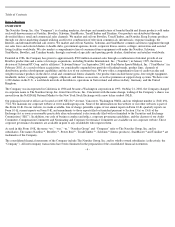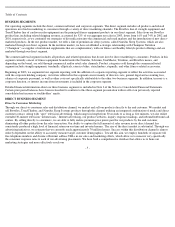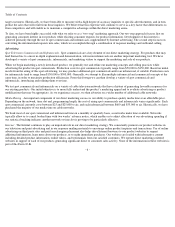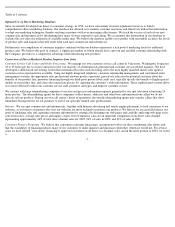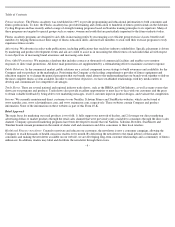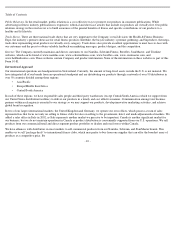Nautilus 2003 Annual Report Download - page 12
Download and view the complete annual report
Please find page 12 of the 2003 Nautilus annual report below. You can navigate through the pages in the report by either clicking on the pages listed below, or by using the keyword search tool below to find specific information within the annual report.
Table of Contents
building our portfolio of brand names, we have greater ability to compete in the international marketplace in which our main competitors have
benefited for many years from the ability to negotiate “package deals.”
We believe our brand names have strong recognition in the international
marketplace, which will allow us to compete more effectively in the future.
Sales outside the U.S. represented approximately 13%, 10%, and 8% of consolidated net sales for 2003, 2002 and 2001, respectively.
Seasonality
In general, sales of our retail fitness equipment are highly seasonal. We believe that sales within our commercial/retail segment are
considerably lower in the second quarter of the year compared to the other quarters. Our strongest quarter for the commercial/retail segment is
generally the fourth quarter, followed by the first and third quarters. We believe the principal reason for this trend is the commercial/retail
fitness industry’s preparation for the impact of New Year’s fitness resolutions and seasonal weather patterns related to colder winter months.
CONSUMER TRENDS
We believe our organic growth has benefited from a number of demographic and market trends that we expect will continue, including:
•
Growing global consumer awareness of positive benefits of good nutrition and fitness;
•
Expanding media attention worldwide on health and fitness;
•
An aging population that is maintaining a more active lifestyle;
• Continued attention to appearance and health by consumers, which is expected to increase as the “baby-boomers” pass through their
40
’
s, 50
’
s, and 60
’
s;
•
High healthcare costs that are focusing more attention on preventative practices like exercise;
• Growing rate of obesity which, according to the US Centers for Disease Control and Prevention, increased by 74% among US adults
between 1991 and 2002;
•
Government financial support for health and fitness programs intended to combat the growing obesity crisis in the United States; and
We believe these consumer trends bode well for our future growth prospects. Just as the “baby boomers,” those Americans born between 1946
and 1964, started the modern fitness movement, we believe they will continue to be a driving force as they age. According to the Sporting
Goods Manufacturers Association (the “SGMA”), the population of Americans fitting this demographic profile is estimated to be around 77
million. We believe baby boomers will use more of their increasing leisure time for exercise and more of their disposable income for fitness
equipment purchases as they strive to counter the effects of aging.
Trends in Exercise Equipment
• Expansion of the market for sophisticated high-quality fitness equipment for the home due to consumers’ continued demand for
higher levels of efficiency in their workout regimes.
Since 1990, the fitness equipment industry has more than doubled in size and has been the most successful category of sporting goods. Interest
in exercising with fitness equipment is supported by the increase in health club memberships in the U.S., which according to the SGMA, have
increased 75% from 20.7 million in 1990 to 36.3 million in 2002. Consumer interest in health clubs has benefited the market for home fitness
equipment as well as the commercial fitness equipment business. Consumers who utilize health clubs are exposed to an array of fitness
equipment products and brand names, as well as education about the uses and benefits of fitness equipment.
-
11
-


